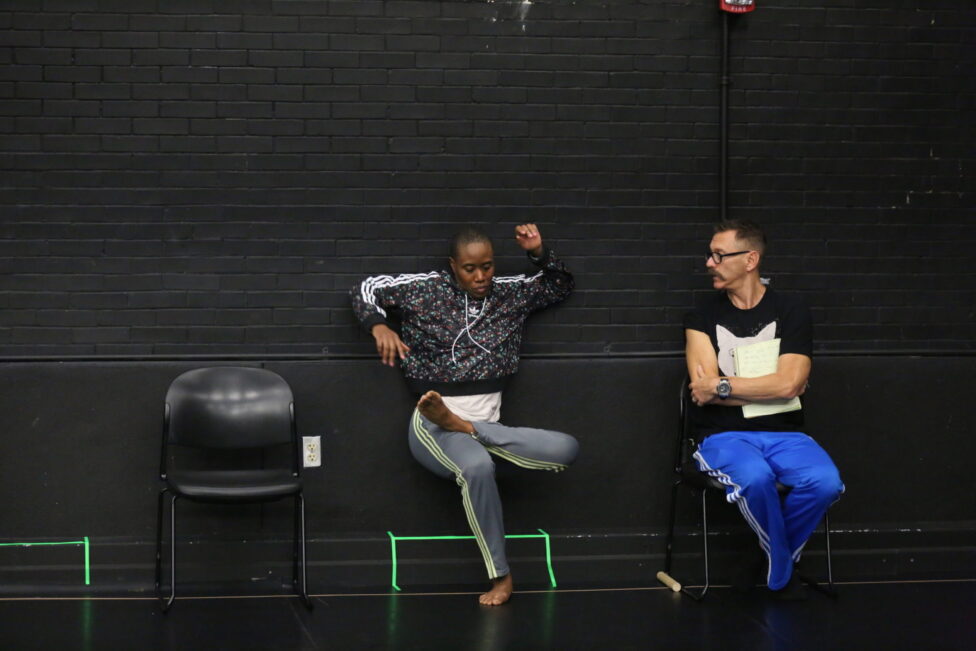Biba Bell: You were bringing in the dancers’ improvisations more, whereas historically they worked from your improvisations.
Neil Greenberg: For 15 years we worked with just my improvisations, but now for some years I’ve worked with the dancers’ improvisations as well.
BB: Since?
NG: Since Really Queer Dance With Harps, which was the first full scale piece working with everyone’s improvisations. Quartet With Three Gay Men, a shorter work that was my first try at including the dancers’ improvsations, was 2006, then Really Queer Dance with Harps was 2008. So this is my fourth big project working this way.
BB: When improvising, what is that process?
NG: The beginning of the rehearsal period is so different from what happens later. In the beginning we would just work on improvisations for a couple of weeks, and then we start videotaping some improvisations. For that first period I brought in some ideas— physical ideas, about the body, but these were all in the service of some other ideas. I can tell you what they are if that’s what you’re interested in.
BB: Sure!
NG: Really Queer Dance with Harps was about avoiding censorship. That’s what it came down to: the queer. The queer became thinking about what is not allowed, what is censored. What does society censor? What am I censoring? Because I’ve internalized society. And the censored could be movements that have associations. The obvious one for me is gender associations, like I’m not supposed to bend my wrists. Boys aren’t supposed to bend their wrists in ballet class. A ruler was actually taped to my wrists for a day to train me in what I was not supposed to do. That’s just the obvious… Also self-censoring my walk… That’s my own personal history with that gender policing that’s in the piece. I thought, we need to talk about censorship. Anything that we weren’t doing because we were judging it. And then we were looking at embarrassment as a clue. If I’m moving and I start to get a little embarrassed and I move away from what I’m doing, maybe that’s censoring. Instead, what happens if I just stay with it and let it exist. In those days I was thinking more in terms of what I now think is a fallacy, not a useful way to think, Oh so then we’ll end up with a lot of movement that doesn’t have associations. We’ll take the associations away.
I started using this as an example [Neil waves his hand repeatedly] this is waving, it became how I describe a movement that has associations.
BB: That’s definitely something that you’re still engaged and invested in. How would it be a stripping away?
NG: Well, we would talk about filling it with body. So it becomes the body doing something. Usually a wave becomes a symbol. The notion of “chair,” it isn’t a particular chair.
BB: Yeah, every moment you have the stick [a prop in the performance] in a different position the gesture changed drastically.
NG: Absolutely. The stick in a different position. The moment you identify an image as a soldier, it could be any soldier. If you stay with it long enough it could become this soldier, though I probably don’t stay with the soldier long enough. Well, I stay with this [gestures like wielding the stick overhead] which is like Game of Thrones! [laughs].
BB: It is so martial.
NG: Yeah. I don’t know if it ever transforms. We talked about things transforming. If there’s an association for something then it doesn’t go away. It’s a part of what it is. So if this is somebody waving, and waving can mean ‘hello’ and ‘goodbye,’ the association likely never leaves. But it’s changes of speed; it’s changes of space; it’s changes of body—is it wrist or shoulder or … It’s body, too. Filling it up with body so it exists more three-dimensionally than as the symbol
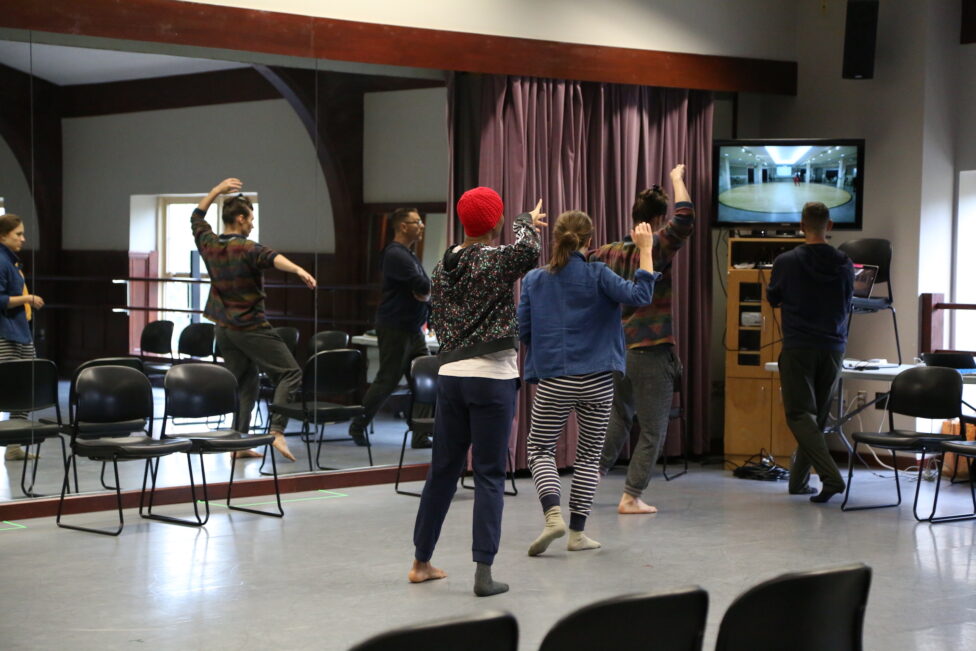
photo by Chris Cameron.
ID: Omagbitse, Kyli, Opal in rehearsal clothes stand in a line facing away from towards a television monitor in the back of the studio. All have their right arms cocked backwards mimicking the screen. Neil closest to the monitor, stands in b-plus watching the screen.
BB: I was reading, something you’d discussed in maybe the MANCC blurb, about this sort of summoning. Not the evacuation of associations or ideas or meaning. But there’s a summoning. And the work is really about the action in producing a relationship. Not the thing that it’s summoning. I’m imagining you and I had this moment, I can’t remember if it was a Levi-Strauss or Victor Turner, but I was transported “in the forest of symbols.” And you’re bushwhacking your way through!
NG: Kind of! I really like that.
BB: There are so many images and they can be contradictory. But they’re all there and it almost becomes an affective thing—what sticks in that moment? Then it goes away and something else begins to stick.
NG: And why does it stick?
BB: Right.
NG: I’m hoping that at some point people realize the situation of being in the round, of seeing other audience members, which didn’t happen as much [at the showing] yesterday. We finally had one completely filled seating area earlier this week. It’s the only time we’ve had that so far and people really watch each other watching. Especially when a dancer is interacting with a viewer then you really watch the people watching. I’m hoping that becomes a part of it—the relativity. This is being summoned for me but I really have no idea if it’s being summoned for the person I’m seeing over there. So the audience can start to become self-conscious about what they are summoning. It’s on the viewer; it’s not really on us performers. But it is! I’m not saying not at all. We’re part of the equation when we summon a meaning.
BB: Absolutely. There is a way this becomes a type of reflection, refraction, sharing with the audience. I felt that with the dancers in terms of the directness of the exchange, which then, because that was happening, made it much easier to watch other people watch.
NG: Because there was a direct exchange between the dancer and the viewer. You say you were watching this connection…
BB: Yes, I had the sense that people were not comfortable. You have to get the audience to embody the space of being watched in a way that isn’t awkward or kind of harsh sometimes.
NG: Yeah!
BB: You’re thinking, Put the house lights on and now we’re watching the audience.
NG: It becomes uncomfortable.
BB: Yes, but the way in which that happened, I noticed a softening with the audience in terms of sharing that gaze with one another.
NG: That is actually the newest thing we’re working on for this project, which I haven’t consciously worked on much at all for years, the particulars of the relationship to the audience.
BB: It’s really exciting.
NG: We worked a lot on that. We thought through it and came up with new ways for me to think about it. In relationship to the audience, there are a lot of possibilities.
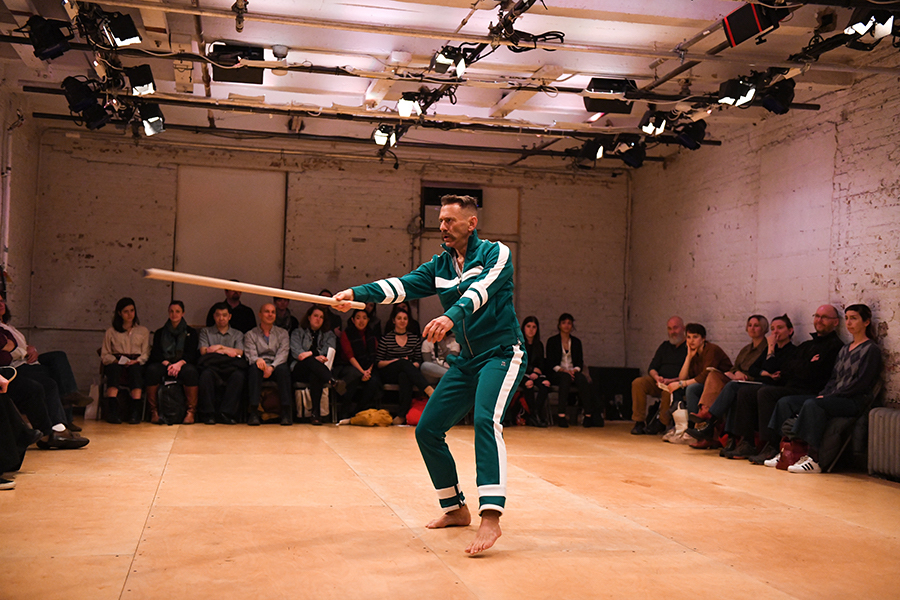
photo by Paula Lobo.
ID: Neil, a white man with short hair and a mustache, stands in the center of the Chocolate Factory in performance in a green jumpsuit with white stripes. His weight is on a bent right leg as he points a long wooden rod out in front of him. The audience is seated in the round under soft amber light.
NG: In Really Queer Dance with Harps there’s a section from Paige [Martin]’s improvisation where we were doing these temps levés across the stage. It referred to ballet and usually would be embarrassing for us but instead we filled the stage with this really excessive—those were the words I was using then. Things about excess, or things that are more vague or ambiguous or nuanced; movement that can get censored by the process of learning the movement. When things get clear. When things get skeletal-muscular. Learning from the video you can’t see skeletal-muscular. You can see lines. It’s really hard. Things tend to get overdrawn. Movements that were drawn in pencil end up drawn in ink. With that dance we worked with our organs so we could get into some qualities that are not drawn that clear way. Which is a real bias about our culture—skeletal-muscular. That’s what most people think of when they think of body and anatomy, and it’s only one body system.
BB: And Dance also.
NG: And Dance! Yeah. That’s how it’s taught, usually. An anatomy course for dancers is usually only skeletal-muscular. We’re censoring every other body system in a way! The attention to them, and they’re always there and they’re always a part of what is happening. With (like a vase) I was thinking about the speech metaphor. I remember you and I have talked about that.
BB: Yes we did.
NG: Speech metaphors. What is this dance saying? What is this movement saying? It’s very related to censorship. We censor something because of the meaning it has taken on, because of what it says. (like a vase) looks for alternatives to the speech metaphor. I explained, “You know, like a vase.” You don’t necessarily ask what this vase is saying, you just experience the vase. And how it’s different from that vase and when you put two vases, multiples, together, or different vases side by side. There was a continuum: on one hand there’s the speech metaphor, which is announcing the action as expression. I’m expressing. Which is why most young people are drawn to dance, because it feels like a great expression. They always say, expression, self-expression. I finally am saying… So, on the one hand, the speech metaphor. And on the other hand, like a vase. Further away from expression. Like an object. A continuum, and I’m travelling back and forth on that continuum.
And, just very quickly, for This, I was mad at one review in particular for (like a vase) that kept asking “Why aren’t the dancers looking at each other?” Well, they don’t have to look at each other to be in relationship. Now it has to do more with a performance convention that we were participating in. It probably comes from me, and it probably comes from Merce [Cunningham]. This performance convention of always getting your cues without turning your head. If the movement is here [reaches up and overhead], if it’s a side bend it’s a side bend. It’s not a [turns his head dramatically off spine axis to look out past armpit]. At least in Cunningham-speak. It’s kind of clear.
BB: Yes. That would be the comic, bringing in the comedy. [laughter]
NG: Yes, definitely. In Merce’s work any aberration like that would be really funny.
BB: That’s interesting. And now it’s really broken, it’s happening and brought into the work. I had the sense that it is very set. It’s entirely set within the lexicon of the movement–these expressions, these moments of exchange with the audience.
NG: The performance stuff became very interesting to me for To The Things Themselves! And it wasn’t what I started off thinking about. I had some people come see my solo last December at Cathy Weis’ and I did it again at the Chocolate Factory for a few people and Wally Cardona commented about my performance, assuming everything was conscious, which was when I realized it wasn’t conscious. That I was doing all these things but I realized I wasn’t conscious of them yet. So we started working on performance as one of the things themselves. Obviously: To The Things Themselves!—you get the phenomenological reference. My starting point was trying to get the meaning out of the culture, out of the body, or out of perceptions. So that was a utopia, I thought, can’t we just be children perceiving in an open field?
BB: Sounds phenomenological.
NG: Does it? I’m trying not to quote phenomenology too much because I don’t really understand it, although maybe I understand it better through these explorations. Antonio Ramos’ use of nudity is very utopian, child-like, before we had shame, pre-shame. So this would be, I see that you’re white, but I don’t immediately have a power relation with that whiteness. I see that you’re a woman but… Anything! Whatever. I’m trying to bring it to important things like that, because… well, they’re important! Race, gender, class—all of it. Power structures. So, at first it was an open field and then thought, that’s impossible. We’re enculturated adults. Even for enculturated children it’s impossible. We live in a world of meanings, and our languages are constructed. Forget it. They’re systemic, how systems have meanings that preclude other meanings.
In my solo, it’s “bathing beauty” when I do that [poses], it’s something! It’s not without meaning. So can that somehow get destabilized?
BB: It feels like there are these archetypal or iconic figures. They move it out into this place that potentially could be utopic, or re-imagined from materials that become almost magical.
NG: Oh man. Re-imagined. Is “magical” related to “imagine”?
BB: I don’t know! It probably has some sort of relationship. I’ll have to look up that etymology. But, to evacuate meaning, who can access and enter that space with you?
NG: That’s a really good word, evacuate. I immediately think of oxygen getting evacuated. There’s no life!
BB: Yeah, there’s no life.
NG: There is no life without culture. That’s a word I bring it to. Culture. Context. That I live now, here, with you, and not with other yous, cultures. With This we talked a lot about objects. And then that leads itself to dance objects.
BB: And then you have objects in the piece, literally.
NG: Yeah. So this [gestures] becomes a dance object. Just like I brought vases onstage for (like a vase), we bring objects onstage. It’s to get a little distance. As an object as well, the audience perceives to hear what we’re saying—and what we’re expressing too—but it’s also, Oh I see two people sitting and talking. What we’re saying might not be very important at all. It’s that we’re saying. Which goes way back in my work, to the idea of MacGuffin. The very beginning of what I think of as my choreographic project was a piece I made called MacGuffin or How Meanings Get Lost in 1987. It was Hitchcockian. Do you know MacGuffin? It’s a Hitchcock word. He coined it. It means the thing in a film that motivates the characters’ actions but about which the audience needs to understand little or nothing at all.
BB: Okay. The MacGuffin.
NG: The MacGuffin. He says in spy stories, it’s always the papers. In heist stories, it’s always the necklace.
BB: The necklace. The diamond.
NG: The diamond! In my favorite Hitchcock film Notorious, it’s a wine bottle filled with plutonium.
BB: That’s great.
NG: It’s important to the characters. It begets trust issues. So really it’s a story about trust. Not a story about the wine bottle!
BB: But it sets it in motion.
NG: Yeah. Our meaning is very important to us. What we’re discussing is important and yet it’s not the most important part. Sort of a MacGuffin.
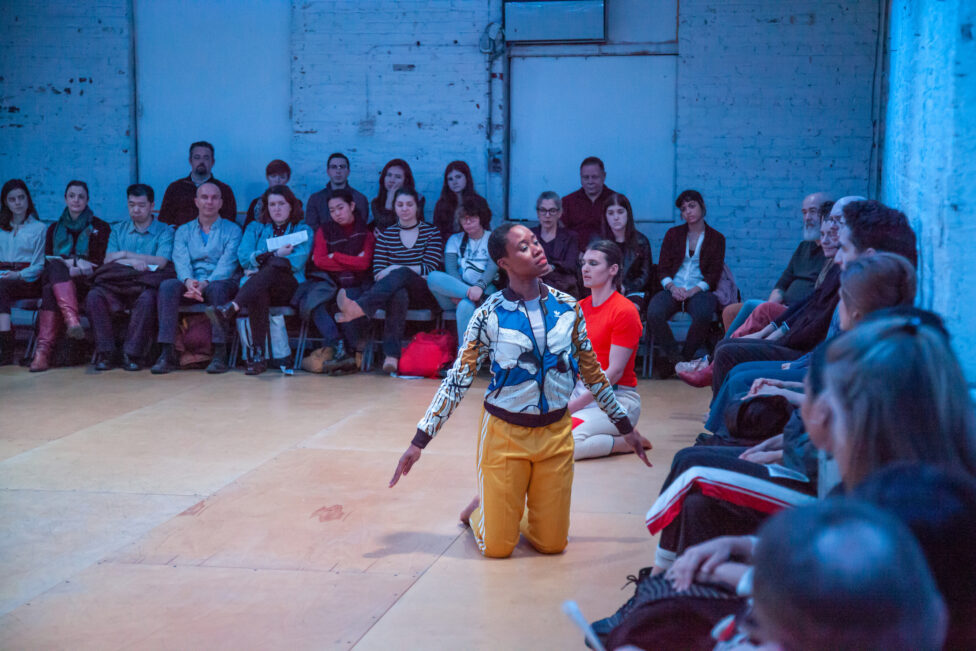
photo by Frank Mullaney.
ID: Omagbitse, a bald Black woman, is on her knees in yellow track pants with white stripes and a blue and white patterned windbreaker. With arms in a low “v” at her sides she cocks her head towards an audience member while the rest of the audience in the round watches.
BB: I’m thinking about the process of transferring. How was working with an improvisational practice? How were they led or the kinds of prompts or investigations?
NG: I have a list of prompts on my computer.
BB: Okay! Would you be into sharing that?
NG: I could share that with you. They’re short-hand so you might not understand. I could tell you what they meant to us. Basically, we work for a couple of weeks talking and improvising, talking and improvising. Then we have a day of videotaping.
BB: Bringing it into that space of a study, which makes me think of the phenomenological strategies. Would it be interesting if there were multiple cameras?
NG: With the trios I only had two cameras but it’s the first time I’ve used multiple cameras. The first time I recorded multiple people improvising was for This. Actually, I tried recording two people improvising at the same time with Jmy [James Kidd] and me once in California, and I really didn’t like what it produced that day. But then I tried it again and found the problem using only one camera was that sometimes the dancers would be in line with the camera—one in front of the other—so you could only see one of them. For This we made the rule that the two dancers had to always be in a different half of the studio. If one person crossed center to the other half it meant the other person had to cross center too. With To The Things Themselves! I tried recording trio improvisations. When those same issues of visibility came up, I taped with two cameras. That way we could see different views, so the dancers didn’t have to have those spatial rules. It produced something new for me. It was great.
BB: Watching a two-dimensional image that mirrors the actual image, then filling it out and embodying it is a very distinct process.
NG: Yes. And the movement becomes an object. Something that was originally an expression.
BB: And now separate.
NG: So, expression becomes this object. It’s a very funny relationship.
BB: I had the experience of watching your solo and maybe having a Wally Cardona moment, thinking Wow! There is so much going on! And it’s so filled and embodied, yet there is a sense of that self-reflexivity, of being within a choreographic structure or object and watching you negotiate that while having an experience with it. There’s a lot in the moment of witnessing you as a performer.
NG: It really is.
BB: And it becomes expressive in a very different way. There were moments with the trio, as an ensemble and within their solos, that I felt that it wasn’t as prominent.
NG: That they weren’t existing within a choreographic structure?
BB: Maybe their negotiations of the experience in real time. Does that make sense?
NG: As the choreographer one assumes that I have a lot of agency within this.
BB: Exactly. Agency comes up.
NG: One assumes that if I wanted to I could just change what I’m doing, or the way I’m doing it, in the moment of performance. But the dancers don’t have that agency. They aren’t in my mind. I’m in my mind, so at the moment if I decide… which I don’t do by the way. I don’t change my structures! I try not to. In the same way that they try not to.
BB: Well, that’s the work. Do the interactions start to address this choreographically?
NG: There’s a bit of agency in that. I wonder if people notice. They probably don’t. We’re all making spatial choices.
BB: In real time?
NG: In real time.
BB: In relationship with the audience? And with each other. I noticed that.
NG: You did?
BB: Well, maybe it will be different seeing it again but I felt a lot of charge with proximity. That was super real.
NG: There’s also a game where they make straight lines with each other but it’s not set at all. So, wherever the first person goes, whatever location the second person chooses by definition makes a line, and the third person has to continue working with the line that’s been set up.
BB: I had the sense that every time they walked in and they placed themselves in the space there was a real intention about it.
NG: In my proscenium work I’m so persnickety spatially. I set space almost obsessively. But with To The Things Themselves! I tried working more with free space–my solo is almost completely free space. We have some directives about periphery and sharing, doing things to different directions and different locales, to different portions of the audience. How and whether to do that.
BB: It’s just a different way of setting it.
NG: Yes, it is. But for me that is a total letting go of control.
BB: Totally, because you’re also doing it all in relation. Everything is set in relation.
NG: Right. Including the relation that I just created. I created that I’m doing it here. So now I’m doing the next thing in relation to that. And for the viewers, I just made something happen for these viewers, and these other viewers had another experience. We’re really self-aware of the viewers. That’s new. This piece is explicitly concerned with the performance.
I’ve developed these performance scores that I’ve worked on over the years with students, for improvisation classes. They’re about different ways of constructing relationship with the audience. The most obvious score is Fourth Wall/Not Fourth Wall. And that’s so big. I brought that up and Molly [Leiber]–who was initially in the project but had to drop out, she has a new, young child, it was very traumatic! But now we have Kyli and I adore Kyli–but Molly said, “Oh, I realize I always perform with the fourth wall.” I call that the fiction of the fourth wall. (That’s another, obviously related, score, Fiction/Non-Fiction.) But back to Fourth Wall/No Fourth Wall…There’s a fiction going on with the fourth wall. The fiction is we’re pretending that there’s a wall there.
BB: Creating a world.
NG: “Key-hole choreography.” Like the viewer is looking through a key-hole at something that’s just going on, would be going on anyway.
BB: With access – a window in.
NG: A window in! Perfect. But it’s more like a one-way mirror. Really! A one-way mirror.
BB: A one-way mirror.
NG: Yeah [laughing]. So as we worked on that, we decided there will be viewers all around, on all sides. The way that Fiction/Non-Fiction gets manifested, is through the gaze. The eyes. I can be looking…. I was taught to… on a proscenium, in a particular José Limon work, to “have a conversation with the gods” when you’re dancing. A conversation with the gods!
BB: I could see that. That’s also when the title starts to resonate because To The Things Themselves!, you’re also talking about the form, which is that, in a sense.
NG: That that’s a thing? The way you’re performing is a thing?
BB: Yeah. Definitely.
NG: And our relationship is a thing. Relationship is…
BB: It’s part of that thing.
NG: It’s a thing!
BB: And it brings it into the room. It becomes substantial. We could get stuck in that phenomenology zone of history which is sort of the utopia, the doesn’t exist zone.
NG: Was that what phenomenology was aiming for?
BB: There has definitely been some, not necessarily recuperation but let’s retell this… what happens if. Like Sara Ahmed, she has this text called Queer Phenomenology and I love the way she discusses the actual context and bodies and subjectivities that are producing this mode of possibility. Which are white, European, male, straight, and can sit at a desk for hour upon hour and have this kind of orientation. Something to go back to. There are ways that can be useful but it’s about doing the work of moving, or deviating, it.
NG: That’s what we’re doing. We’re moving subject to object.
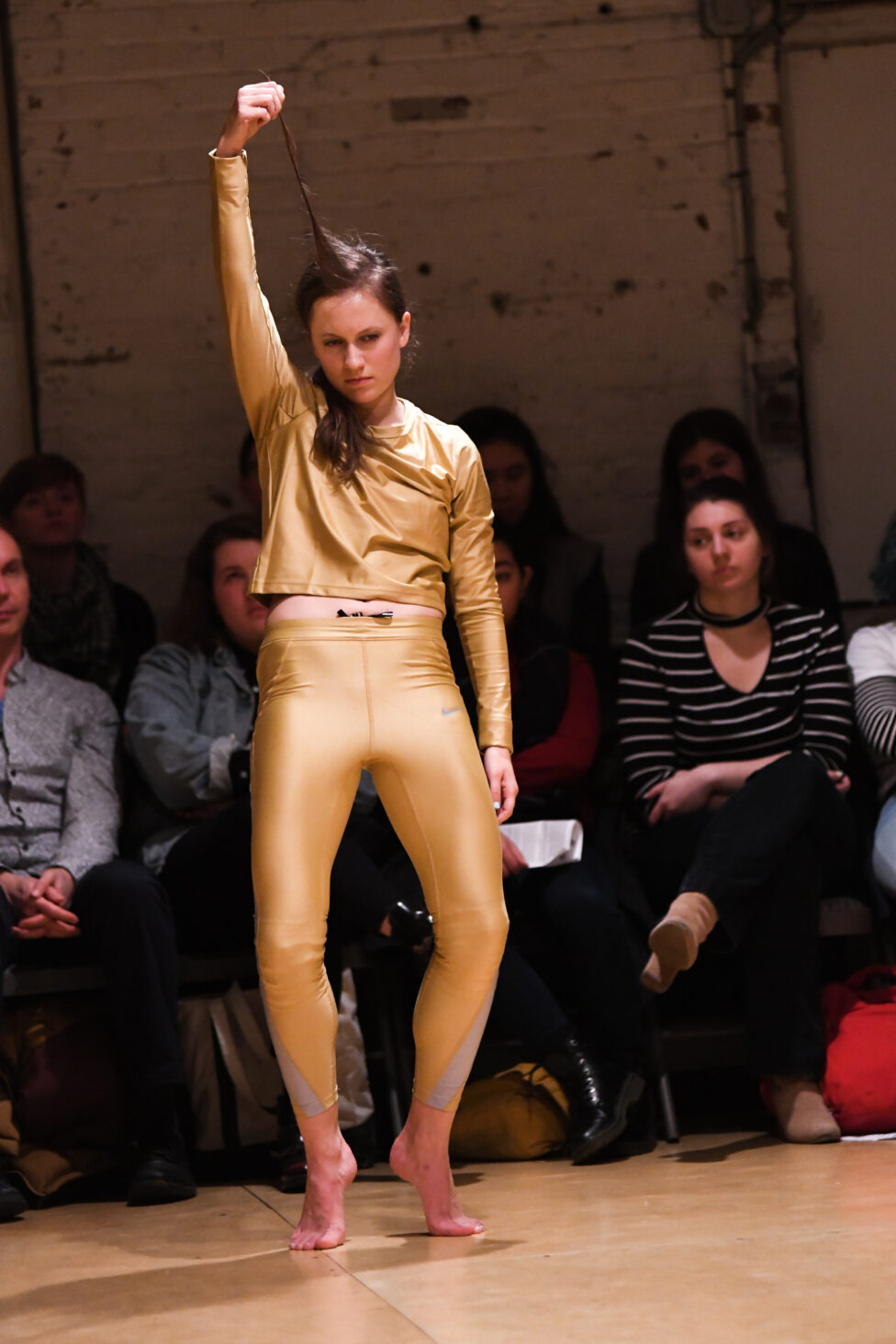
photo by Paula Lobo.
ID: Kyli, a white woman with brown hair, stands in first position relevé with a forced arch in matching gold leggings and long-sleeved shirt. Her right arm is fully extended holding a large strand of hair with her fingers above her head, while looking down and concentrated.
BB: Things have agency. The object animated is another way to talk about it.
NG: I really want to tell you about something that came up in rehearsal. I’ll cut right to it. Merce talks about a tightrope. “The dancer must walk a tightrope.” (I always do my Merce voice, which is really my father’s voice.) “The dancer must walk a tightrope. On one side of the tightrope is the step.” I love that he called it the step! “On the other side of the tightrope is the dancer.” The Step, I’ve taken to mean form, or the choreography. It’s the score, the instruction. It’s what you’re doing. It’s the object. And who the dancer is, how that dancer moves, is the person who has agency. And the dancer has to walk a tightrope and not fall to either side. Never go so far into the step that the person isn’t there and never indulge selfness so much that you aren’t doing the step. In a way he was saying… The step then becomes Merce. The step is Merce!
I hadn’t thought of that before. But it is. Just like it’s me.
BB: Right, the choreographer.
NG: I’ve always felt that the relationship with the viewer is also a part of this continuum, this negotiation. And I feel that physically. Another continuum is the body’s relationship to the floor and the space, the ground and the space, and stretching into the ground and stretching into the space. But when the audience comes in suddenly there’s this other pull! [Gasps] In performance or when we’re rehearsing in the studio, and then become aware that someone is watching, I get pulled off sometimes.
BB: The audience.
NG: So it’s a triangle for me: the step, the performer, and—I don’t know what to call it—the viewer? The relationships with the viewers. And these are relationships with the steps. Then you have to negotiate this arena. And don’t fall off. Because the trouble with falling off is that it’s hard to get back into the arena. We’ve been talking about our performance defaults. Each of us, we’ve talked with each other about our defaults as dancers, as performers. Where we go most. When we click into performing, where we go.
BB: Our expectations of a particular kind of work.
NG: Right. And our default. It’s hard to have new possibilities within the default. It becomes subject instead of object.
BB: It becomes phoned in?
NG: It’s not necessarily phoned in. For instance, my default is suddenly going from zero to a hundred. All of a sudden. When I was dancing with Merce, my punctuation was always an exclamation point. There’s not a lot of nuanced expression in text message communication with exclamation points always. Like the person who always dances with commas. No periods or anything.
That’s what we talked about the other day. That you play with it and this is a part of working on a continuum, staying within an arena. The dancers sometimes say of their solo improvisations, “in this section I remember I was thinking about this thing,” from our list of improvisation values and interests, which I’ll send you.
BB: That’s really interesting. There’s repetition and facing changes. So, now the object’s here or now the relationship’s here. How does it change the way we look at this thing?
NG: That’s really interesting. Just facing changes does such a huge thing.
BB: Absolutely.
NG: And I always knew that on a proscenium stage. Conscious of, can we see the face? What is our view of the face? Dancers often think of it in terms of pelvis. I do a lot of the time. Where the pelvis is facing, that’s my facing. Or feet. But it’s really face.
BB: And then, you’re dealing with distance and proximity with the viewer.
NG: Some guy who came on Tuesday was really smart. He was talking about foreground and background.
BB: That came up so much for me. The background, what you’re working with as background, shifted. In some ways I thought meaning-making was the background, and what comes over. I love that part at the end… what do you say?
NG: We’re really questioning that right now. You love that?
BB: I do!
NG: Why do you love it? What does it do?
BB: You’re sitting there and all of a sudden we can appreciate… it felt really honest.
NG: Oh! Good. It feels really contrived sometimes. I have to find different ways to do it if I’m going to do it.
BB: It indexes the piece with you, in terms of the force that you bring into the space and in the first section with the solo. In terms of punctuation. There’s a little bit of…
NG: … me again …
BB: … at the end. And that inspires that kind of burst that happens. A waning, a thinning out and a moodiness I felt with the solos. Especially handing off of the little stick moment—what came before and what happens with Opal and Kyli. That was really [laughs]… Whoa!
NG: That was a thing!
BB: Yeah! You really have to go there on the most obvious level. I feel like I’m tracking the performer’s attention because you’ve brought in the components of that direct exchange with the audience. That also thins out.
NG: But what about Omagbitse’s solo?
BB: Omagbitse definitely brings that into her performance because she’s so expressive. She’s doing the thing that she’s having an experience with the thing. That’s how I was interpreting it. Then it moves into Kyli and Opal and goes into another zone. I was thinking about lighting here.
NG: Me too. I’ve thought the lights could get a little more night-clubby. The lights are going to be lighting us by lighting the room. So that’s why I was thinking night-clubby.
BB: When you come back you give that invitation or proposal.
NG: Should there be a spotlight on me?
BB: I don’t know! Maybe. It snaps it back.
NG: What if I use a microphone?
BB: Then you would finally use the microphone.
NG: It would be a funny joke. That would be a Chekov-ian moment, the if it got on the stage in the first act you’d better use it by the end. But I also think we do use the microphone.
BB: Oh definitely.
NG: Just not for its expressive purpose.
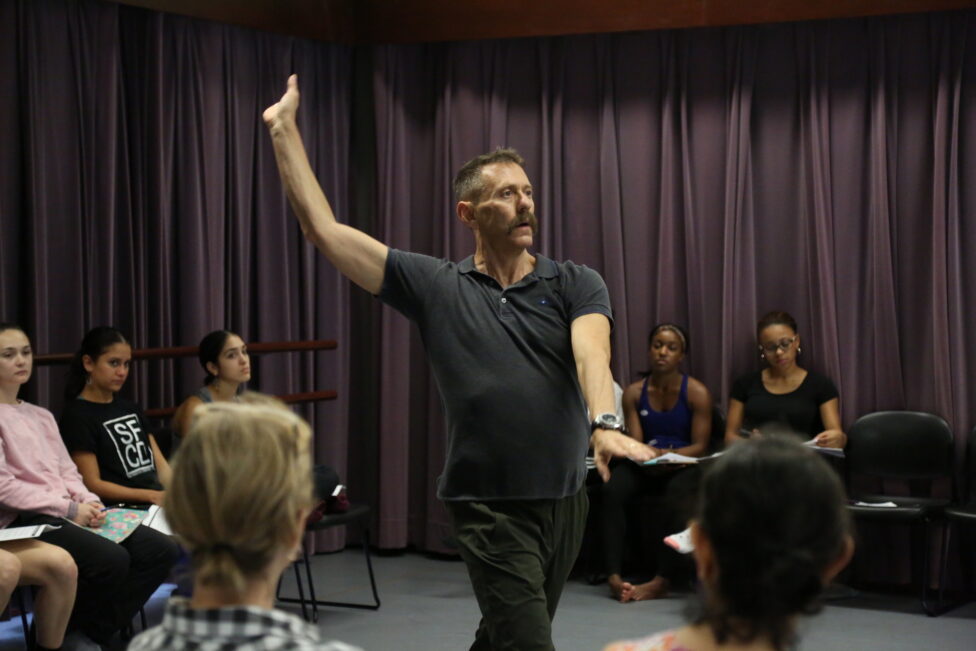
photo by Chris Cameron.
ID: Neil strands croisé with the right arm up and back and the left forward and down, in a rehearsal studio showing with students seated in the round. He wears a dark polo tee-shirt and dark pants and looks far away off to the left.
Cover Image Description:
photo by Chris Cameron. Omagbitse leans up against a dark brick wall in rehearsal, sunk down in a figure-4 position next to Neil Greenberg seated to the right watching, in a tee-shirt with an illustration of a cat’s head on it and glasses, clutching a notebook.

